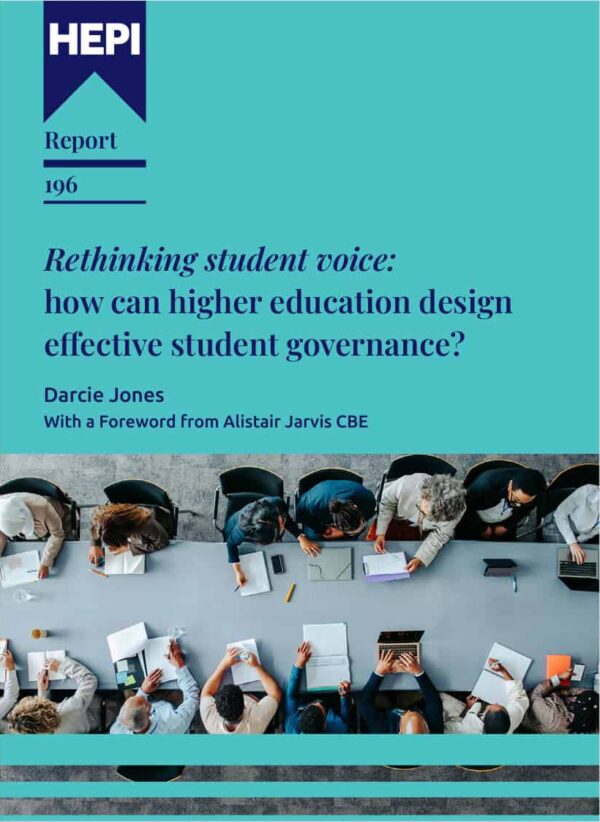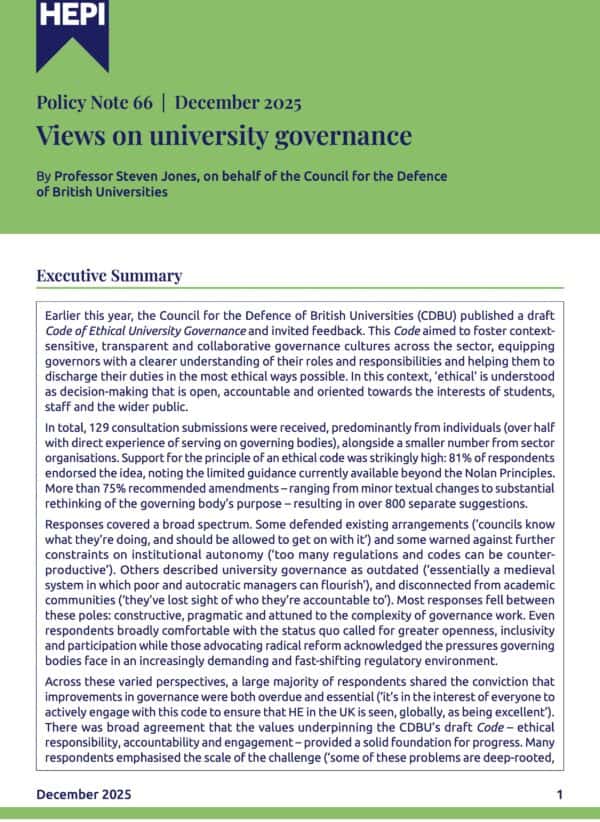Risk-Sharing: Trump’s “Big Beautiful Bill” — Implications for UK Higher Education
By Peter Ainsworth, a consultant and writer on higher education finance, known for advocating structural reform that aligns university incentives with real-world graduate outcomes.
Trump’s “One Big Beautiful Bill” may sound absurd to British ears, but beneath the “very stable genius’s” promotional gloss lies a legislative change designed to reset the relationship between the US Higher Education sector and the state. The bill, which passed the U.S. House of Representatives on 22 May 2025, includes the Student Success and Taxpayer Savings Act (SSTSA) – which, if passed by the Senate, would be the world’s first statutory implementation of institutional risk-sharing in student loans.
Historically, in both the US and UK, universities have been financially rewarded for their enrollment of students rather than for the practical benefits delivered to their customers. Success arises out of customer acquisition rather than service value-add. Students take out government-backed loans to pay tuition; institutions receive the money upfront regardless of whether or not their degrees lead to economic success. The result is a moral hazard: an incentive (payment) structure for universities that is not aligned with the employability gain that students want and taxpayers need. Systematically falling graduate premiums on both sides of the Atlantic reflect the impact of insulating universities from the employment risk their students face in a rapidly changing economy.
The American reform seeks to realign incentives to better align risks and objectives. It introduces an Earnings-to-Price Ratio (EPR):
EPR = (Median Value-Added Earnings) / (Median Total Price)
Institutions with low EPRs – indicating poor graduate earnings relative to costs – will face a financial penalty in the form of an invoice from the US Treasury to cover the estimated student loan losses for the relevant cohort. If the Senate passes the reform, US universities will have a powerful incentive to transform their offer to ensure meaningful real-world earnings gains for their students.
The SSTSA is an advance on the existing Cohort Default Rate (CDR) system, which merely threatened to deny access to federal loans to students of institutions with very high default rates. But there was no direct financial risk. Congress deemed it ineffective and so now proposes something more market-oriented.
Meanwhile, the UK is two steps behind, only now looking to implement a version of the CDR model which the US is already moving away from. A recent Institute for Fiscal Studies (IFS) paper proposes regulating universities based on early-career graduate earnings proxies – like the CDR it is recognising the importance of career earnings outcomes but measuring them indirectly and using regulatory sanction rather than financial cost as the stick. The IFS proposes to use earnings in a three- to five-year window post-graduation to drive regulatory response. Like the CDR’s reliance on a technical definition of default, this short, near-term window will create heavily biased statistics, diminishing the value of professions with delayed earnings trajectories such as medicine and academia.
Further, the IFS proposes to exclude from consideration graduates with very low earnings. This favours institutions whose graduates earn just below an arbitrary threshold level. They also rely on UK tax data which omits emigrants, undervaluing universities that succeed in preparing graduates for global careers.
As Friedrich Hayek argued, complex systems cannot be centrally managed through proxies and aggregated metrics. Graduate career trajectories are dynamic, diverse, and unpredictable — precisely the kind of outcomes that defy simple measurement. Accepting that lifetime earnings are the relevant metric leads inevitably to the conclusion that no bureaucratic proxy will suffice.
There is a cleaner alternative. Universities could be required to issue the loans themselves, something that Buckingham, for example, already does on a small scale. Where needed, to support cash flow, the government could lend to institutions rather than students. This would internalise the financial risk: institutions would have a direct, long-term stake in the earnings success of their graduates. Universities could be freed to set fees and loan terms based on the economic value they expect to deliver and would be incentivised to provide ongoing support — career services, retraining, alumni engagement — to minimise loan defaults over the full life of the loan.
Such a model also addresses bigger challenges facing the higher education sector. Edward Peck, the new Chair of the Office for Students, recently argued that AI is making traditional assessment ineffective and universities must move from testing what students know to what they can do. Meanwhile, Diana Beech and André Spicer, writing for HEPI, have highlighted that universities now employ an average of 17.6 staff solely to handle regulatory compliance and warned that regulation is “multiplying and becoming less predictable.” In this context, risk-sharing offers a route back to institutional autonomy: tying funding to real-world success rather than the IFS’s proposal for even more bureaucratic box-ticking.
Finally, political and fiscal realities support this innovation. A shift to institutionally issued loans would remove the student loan portfolio from the government’s balance sheet, reducing annual write-downs by around £15bn per annum – a present value of around £300bn. That would go a long way to address the various fiscal challenges faced by the Labour government. With less bureaucratic interference, more strategic freedom, and appropriate incentives, the sector should be able to make student loans pay, ensuring a sustainable and prosperous future, and letting British universities blow past their American rivals like nobody’s seen before.







Comments
Charrua says:
Perhaps the final step in the comodification of the individual. We already buy and sell the labor, we are facing continuous efforts to buy and sell the people’s health. Now we see increased efforts to buy and sell the people’s education.
And let’s be honest, we are not trying to buy the best health or education for the people, just the cheapest.
As Jefferson believed: “An educated citizenry is a vital requisite for our survival as a free people”. He didn’t say skillful, productive or high-earner. He founded the University of Virginia, not a technical institute.
Reply
Paul Wiltshire says:
The problem here is that any system that allows fees to be set by the institution, will lead to students having to pay for the ‘brand’ value of the institution rather than the ‘true’ value of the degree in terms of how studying for the degree genuinely improved their ability to perform well in the workplace. We would quickly end up with Oxford, Cambridge, KCL, Imperial and the like successfully getting away with charging UK students £30k + a year. I am fearful that this is just a trojan horse to allow the more elite HE institutions freedom to cash in on their brand value for UK students as they already have the freedom to do for international students. The fee cap should remain in place at current levels rather than risk unleashing a system of spiralling fees and further drive up debts for our young adults.
Reply
Paul Wiltshire says:
Reply to Charrau,
But Jefferson’s quote is mis-represented if you translate it to mean that you should make the individual citizen personally £50-£60k in debt (or far more if we remove the fee cap) for the supposed benefit to wider society.
Reply
Pam Tatlow says:
Astounding that anyone would think that the UK higher education sector and its governing bodies would accept this. The net result in the US will be the closure of some institutions – especially those which recruit the most disadvantaged students. In the UK (or should we say England given the devolution of HE policy and funding) it would be students from the least advantaged backgrounds whose progression to HE would be put at risk and the historic and long-standing policy of seeking to ensure that studying for a higher education qualification was open to all those who were qualified regardless of age and background would be undermined.
Reply
albert wright says:
A more direct financial arrangement between the University and the student makes sense to me and is a move towards a more commercial market model.
We could also remove all the public sector related degrees to an apprenticeship model as they are primarily skills and competence based qualifications.
Reply
Add comment